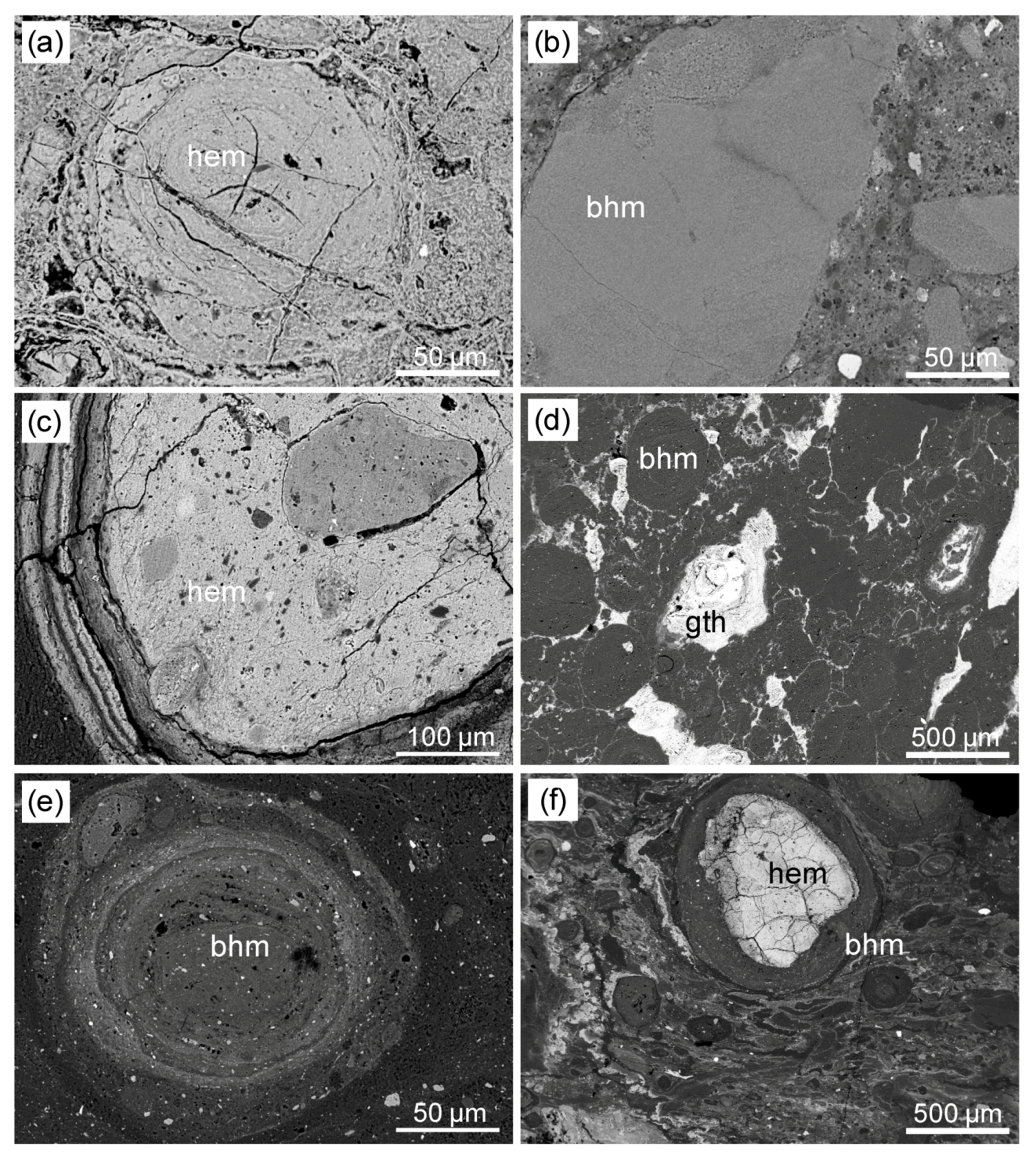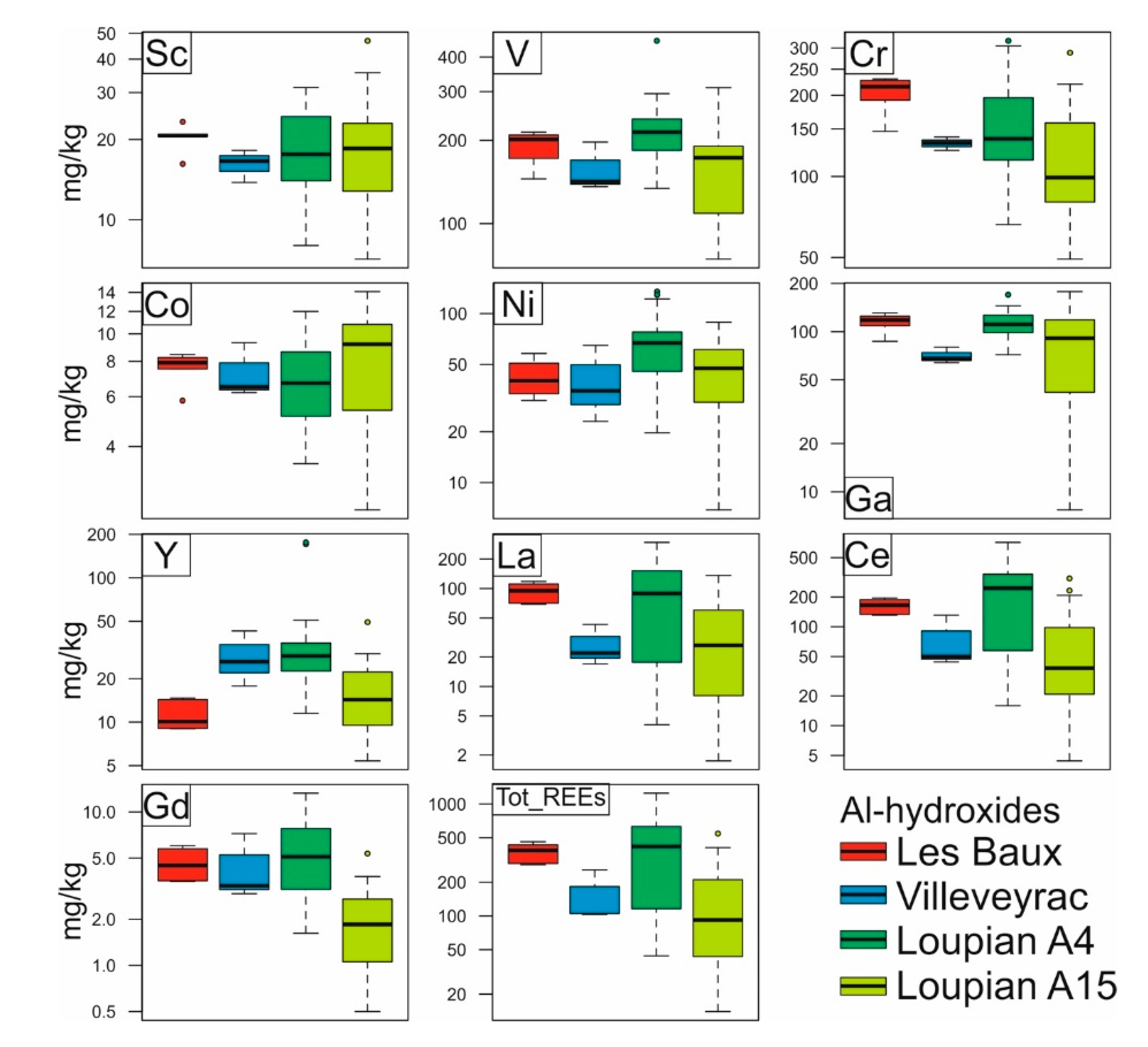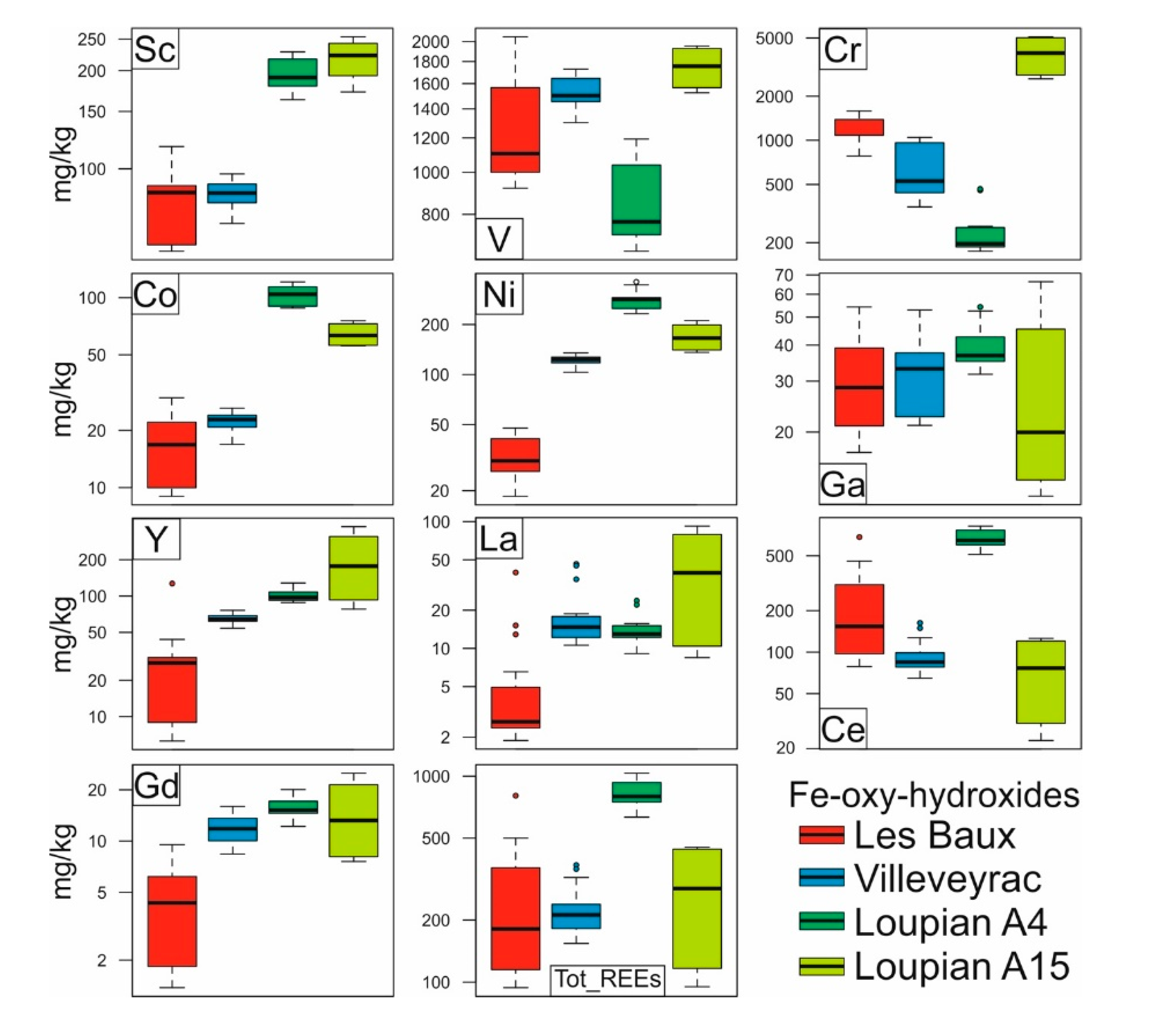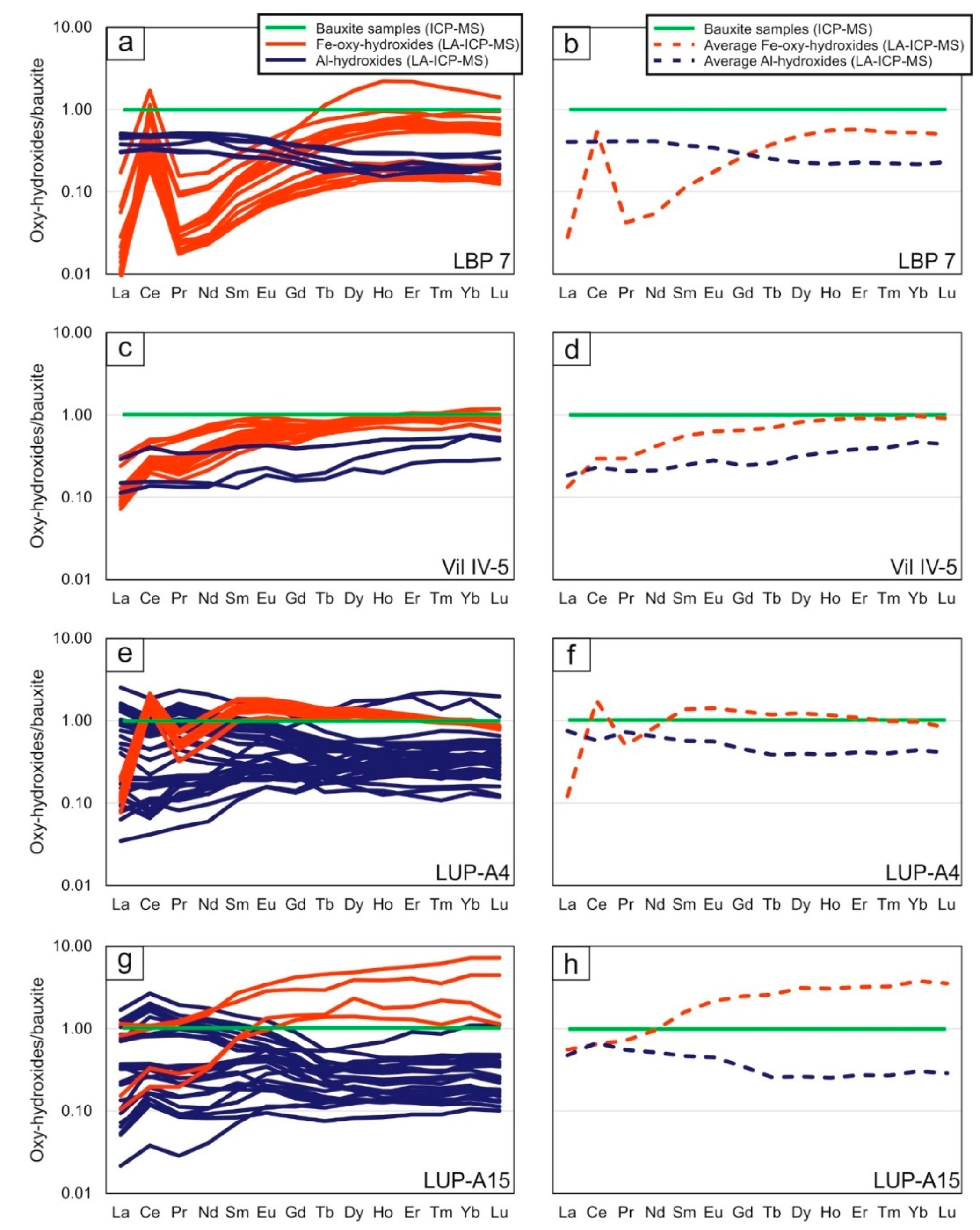Rare Earth Elements (REE) in Al- and Fe-(Oxy)-Hydroxides in Bauxites of Provence and Languedoc (Southern France): Implications for the Potential Recovery of REEs as By-Products of Bauxite Mining
Abstract
:1. Introduction
2. Materials and Methods
3. Results
3.1. Mineralogy and Geochemistry
3.2. Mineral Composition and Laser Ablation (LA)-ICP-MS Analyses
3.2.1. Al-Hydroxides
3.2.2. Fe-Oxy-Hydroxides
4. Discussion
- (1)
- Ce enrichment at the top of the bauxite profiles: this characteristic is mainly related to Ce oxidation from a trivalent to the tetravalent state, associated with the precipitation of cerianite [(Ce4+,Th)O2] [42]. Cerium oxidation and consequent CeO2 precipitation may occur in the pH range of 5–6 [42].
- (2)
- LREEs enrichment at the bottom of the profiles: it is explained by the per descensum model. This can be described as (i) REEs leaching at the top of the profile due to acidic soil solutions (a decrease of the pH of the surficial solutions, possibly due to a decrease of the ionic strength, can cause the conversion of Ce4+ to Ce3+ in the uppermost part of the karst deposit), (ii) downward percolation of the REEs-bearing fluids (REE3+ transported in solution as fluoride complexes), (iii) acid buffering by the footwall limestones, and (vi) LREEs and Ce3+ fixations in neo-formed fluorocarbonates [26,41,42].
5. Conclusions
Supplementary Materials
Author Contributions
Funding
Acknowledgments
Conflicts of Interest
References
- Bárdossy, G.; Aleva, G.J.J. Lateritic Bauxites; Elsevier: Amsterdam, The Netherlands, 1990; 624p. [Google Scholar]
- Bárdossy, G. Karst Bauxites, Bauxite Deposits on Carbonate Rocks (Developments in Economic Geology); Elsevier: Amsterdam, The Netherlands, 1982; p. 441. [Google Scholar]
- Boni, M.; Rollinson, G.; Mondillo, N.; Balassone, G.; Santoro, L. Quantitative mineralogical characterization of karst bauxite deposits in the southern Apennines, Italy. Econ. Geol. 2013, 108, 813–833. [Google Scholar] [CrossRef]
- Lee Bray, E. Bauxite and alumina. In Mineral Commodity Summaries; U.S. Geological Survey: Reston, VA, USA, 2019. [Google Scholar]
- Hind, A.R.; Bhargava, S.K.; Grocott, S.C. The surface chemistry of Bayer process solids: A review. Colloids Surf. A Physicochem. Eng. Asp. 1999, 146, 359–374. [Google Scholar] [CrossRef]
- Mongelli, G.; Boni, M.; Oggiano, G.; Mameli, P.; Sinisi, R.; Buccione, R.; Mondillo, N. Critical metals distribution in Tethyan karst bauxite: The Cretaceous Italian ores. Ore Geol. Rev. 2017, 86, 526–536. [Google Scholar] [CrossRef]
- Abedini, A.; Calagari, A.A. REE geochemical characteristics of titanium-rich bauxites: The Permian Kanigorgeh horizon, NW Iran. Turk. J. Earth Sci. 2014, 23, 513–532. [Google Scholar] [CrossRef]
- Gamaletsos, P.N.; Godelitsas, A.; Mertzimekis, T.J.; Göttlicher, J.; Steininger, R.; Xanthos, S.; Berndt, J.; Klemme, S.; Kuzmin, A.; Bárdossy, G. Thorium partitioning in Greek industrial bauxite investigated by synchrotron radiation and laser-ablation techniques. Nucl. Instrum. Methods Phys. Res. Sect. B Beam Interact. Mater. At. 2011, 269, 3067–3073. [Google Scholar] [CrossRef]
- Gamaletsos, P.N.; Godelitsas, A.; Filippidis, A.; Pontikes, Y. The rare earth elements potential of Greek bauxite active mines in the light of a sustainable REE demand. J. Sustain. Metall. 2018, 5, 20–47. [Google Scholar] [CrossRef]
- Hanilçi, N. Geological and geochemical evolution of the Bolkardaği bauxite deposits, Karaman, Turkey: Transformation from shale to bauxite. J. Geochem. Explor. 2013, 133, 118–137. [Google Scholar] [CrossRef]
- Karadağ, M.M.; Küpeli, Ş.; Arýk, F.; Ayhan, A.; Zedef, V.; Döyen, A. Rare earth element (REE) geochemistry and genetic implications of the Mortaş bauxite deposit (Seydişehir/Konya–Southern Turkey). Chem. Erde 2009, 69, 143–159. [Google Scholar] [CrossRef]
- Ling, K.Y.; Zhu, X.-Q.; Tang, H.S.; Wang, Z.G.; Yan, H.W.; Han, T.; Chen, W.Y. Mineralogical characteristics of the karstic bauxite deposits in the Xiuwen ore belt, Central Guizhou Province, Southwest China. Ore Geol. Rev. 2015, 65, 84–96. [Google Scholar] [CrossRef]
- Mameli, P.; Mongelli, G.; Oggiano, G.; Dinelli, E. Geological, geochemical and mineralogical features of some bauxite deposits from Nurra (western Sardinia, Italy): Insights on conditions of formation and parental affinity. Int. J. Earth Sci. 2007, 96, 887–902. [Google Scholar] [CrossRef]
- Mondillo, N.; Boni, M.; Balassone, G.; Rollinson, G. Karst bauxites in the Campania Apennines (southern Italy): A new approach. Period. Mineral. 2011, 80, 407–432. [Google Scholar]
- Putzolu, F.; Piccolo Papa, A.; Mondillo, N.; Boni, M.; Balassone, G.; Mormone, A. Geochemical Characterization of Bauxite Deposits from the Abruzzi Mining District (Italy). Minerals 2018, 8, 298. [Google Scholar] [CrossRef]
- Torró, L.; Proenza, J.A.; Aiglsperger, T.; Bover-Arnal, T.; Villanova-de-Benavent, C.; Rodríguez-García, D.; Ramírez, A.; Rodríguez, J.; Mosquea, L.A.; Salas, R. Geological, geochemical and mineralogical characteristics of REE-bearing Las Mercedes bauxite deposit, Dominican Republic. Ore Geol. Rev. 2017, 89, 114–131. [Google Scholar] [CrossRef]
- Wang, Q.; Deng, J.; Liu, X.; Zhang, Q.; Sun, S.; Jiang, C.; Zhou, F. Discovery of the REE minerals and its geological significance in the Quyang bauxite deposit, West Guangxi, China. J. Asian Earth Sci. 2010, 39, 701–712. [Google Scholar] [CrossRef]
- Yu, W.; Wang, R.; Zhang, Q.; Du, Y.; Chen, Y.; Liang, Y. Mineralogical and geochemical evolution of the Fusui bauxite deposit in Guangxi, South China: From the original Permian orebody to a Quarternary Salento-type deposit. J. Geochem. Expl. 2014, 146, 75–88. [Google Scholar] [CrossRef]
- Zarasvandi, A.; Charchi, A.; Carranza, E.J.M.; Alizadeh, B. Karst bauxite deposits in the Zagros Mountain belt, Iran. Ore Geol. Rev. 2008, 34, 521–532. [Google Scholar] [CrossRef]
- Jaskula, B.W. Gallium. In Mineral Commodity Summaries; U.S. Geological Survey: Reston, VA, USA, 2019. [Google Scholar]
- Authier-Martin, M.; Forte, G.; Ostap, S.; See, J. The mineralogy of bauxite for producing smelter-grade alumina. JOM 2001, 53, 36–40. [Google Scholar] [CrossRef]
- Mongelli, G.; Boni, M.; Buccione, R.; Sinisi, R. Geochemistry of the Apulian karst bauxites (southern Italy): Chemical fractionation and parental affinities. Ore Geol. Rev. 2014, 63, 9–21. [Google Scholar] [CrossRef]
- Mongelli, G.; Buccione, R.; Gueguen, E.; Langone, A.; Sinisi, R. Geochemistry of the Apulian allochthonous karst bauxite, Southern Italy: Distribution of critical elements and constraints on Late Cretaceous Peri-Tethyan palaeogeography. Ore Geol. Rev. 2016, 77, 246–259. [Google Scholar] [CrossRef]
- Goodenough, K.M.; Schilling, J.; Jonsson, E.; Kalvig, P.; Charles, N.; Tuduri, J.; Deady, É.A.; Sadeghi, M.; Schiellerup, H.; Müller, A. Europe’s rare earth element resource potential: An overview of REE metallogenetic provinces and their geodynamic setting. Ore Geol. Rev. 2016, 72, 838–856. [Google Scholar] [CrossRef]
- Mouchos, E.; Wall, F.; Williamson, B.J.; Palumbo-Roe, B. Easily leachable rare earth element phases in the Parnassus-Giona bauxite deposits, Greece. Bull. Geol. Soc. Greece 2016, 50, 1952–1958. [Google Scholar] [CrossRef]
- Deady, É.A.; Mouchos, E.; Goodenough, K.M.; Williamson, B.J.; Wall, F. A review of the potential for rare-earth element resources from European red muds: Examples from Seydişehir, Turkey and Parnassus-Giona, Greece. Mineral. Mag. 2016, 80, 43–61. [Google Scholar] [CrossRef]
- Vind, J.; Malfliet, A.; Blanpain, B.; Tsakiridis, P.E.; Tkaczyk, A.H.; Vassiliadou, V.; Panias, D. Rare Earth Element Phases in Bauxite Residue. Minerals 2018, 8, 77. [Google Scholar] [CrossRef]
- Vind, J.; Alexandri, A.; Vassiliadou, V.; Panias, D. Distribution of Selected Trace Elements in the Bayer Process. Metals 2018, 8, 327. [Google Scholar] [CrossRef]
- Herrington, R.; Mondillo, N.; Boni, M.; Thorne, R.; Tavlan, M. Bauxite and Nickel-Cobalt Lateritic Deposits of the Tethyan Belt. In Tectonics and Metallogeny of the Tethyan Orogenic Belt, Special Publication; Richards, J., Ed.; SEG Inc.: Littleton, CO, USA, 2016; Volume 19, pp. 349–387. [Google Scholar]
- Nicolas, J. Nouvelles données sur la genése des bauxites à mur karstique du sud-est de la France. Mineral. Depos. 1968, 3, 18–33. [Google Scholar] [CrossRef]
- Guendon, J.L.; Parron, C. Les phénomènes karstiques dans les processus de bauxitisation sur substrat carbonaté. Ann. Soc. Géol. Belg. 1985, 108, 85–92. [Google Scholar]
- Combes, P.J. Typologie, cadre géodynamique et génèse des bauxites françaises. Geodin. Acta 1990, 4, 91–109. [Google Scholar] [CrossRef]
- McDonough, W.F.; Sun, S.S. The composition of the Earth. Chem. Geol. 1995, 120, 223–253. [Google Scholar] [CrossRef]
- Zachariáš, J.; Wilkinson, J. Exlam 2000: Excel VBA application for processing of transient signals from laser ablation (LA-ICPMS) of fluid inclusions and solid phases. In Proceedings of the ECROFI-XIX Biennial Conference on European Current Research on Fluid Inclusions, Bern, Switzerland, 17–20 July 2007. [Google Scholar]
- Longerich, H.P.; Jackson, S.E.; Günther, D. Laser ablation inductively coupled plasma mass spectrometric transient signal data acquisition and analyte concentration calculation. J. Anal. At. Spectrom. 1996, 11, 899–904. [Google Scholar] [CrossRef]
- Dare, S.; Barnes, S.J.; Beaudoin, G.; Méric, J.; Boutroy, E.; Potvin-Doucet, C. Trace elements in magnetite as petrogenetic indicators. Mineral. Depos. 2014, 49, 785–796. [Google Scholar] [CrossRef]
- Hiemstra, T.; Barnett, M.O.; van Riemsdijk, W.H. Interaction of silicic acid with goethite. J. Colloid Interface Sci. 2007, 310, 8–17. [Google Scholar] [CrossRef] [PubMed]
- Hiemstra, T.; van Riemsdijk, W.H. Adsorption and surface oxidation of Fe(II) on metal (hydr)oxides. Geochim. Cosmochim. Acta 2007, 71, 5913–5933. [Google Scholar] [CrossRef]
- Parkinson, G.S. Iron oxide surfaces. Surf. Sci. Rep. 2016, 71, 272–365. [Google Scholar] [CrossRef] [Green Version]
- Granados-Correa, F.; Corral-Capulin, N.G.; Olguín, M.T.; Acosta-León, C.E. Comparison of the Cd(II) adsorption processes between boehmite (γ-AlOOH) and goethite (α-FeOOH). Chem. Eng. J. 2011, 171, 1027–1034. [Google Scholar] [CrossRef]
- Maksimović, Z.; Pantó, G.Y. Contribution to the geochemistry of the rare earth elements in the karst-bauxite deposits of Yugoslavia and Greece. Geoderma 1991, 51, 93–109. [Google Scholar] [CrossRef]
- Mongelli, G. Ce-anomalies in the textural components of Upper Cretaceous karst bauxites from the Apulian Carbonate Platform (southern Italy). Chem. Geol. 1997, 140, 69–79. [Google Scholar] [CrossRef]
- Bolanz, R.M.; Kiefer, S.; Göttlicher, J.; Steininger, R. Hematite (α-Fe2O3)-A potential Ce4+ carrier in red mud. Sc. Total. Environ. 2018, 622–623, 849–860. [Google Scholar] [CrossRef] [PubMed]
- Liu, H.; Pourret, O.; Guo, H.; Bonhoure, J. Rare earth elements sorption to iron oxyhydroxide: Model development and application to groundwater. Appl. Geochem. 2017, 87, 158–166. [Google Scholar] [CrossRef]
- Fairhurst, A.J.; Warwick, P. The influence of humic acid on europium-mineral interactions. Colloids Surf. A Physicochem. Eng. Asp. 1998, 145, 229–234. [Google Scholar] [CrossRef]
- Granados-Correa, F.; Jiménez-Becerril, J. Chromium (VI) adsorption on boehmite. J. Hazard. Mater. 2009, 162, 1178–1184. [Google Scholar] [CrossRef]
- Kraemer, S.M.; Xu, J.; Raymond, K.N.; Sposito, G. Adsorption of Pb(II) and Eu(III) by Oxide Minerals in the Presence of Natural and Synthetic Hydroxamate Siderophores. Environ. Sci. Technol. 2002, 36, 1287–1291. [Google Scholar] [CrossRef] [PubMed] [Green Version]
- McBride, M.B. Cu2+-adsorption characteristics of aluminum hydroxide and oxyhydroxides. Clays Clay Miner. 1982, 30, 21–28. [Google Scholar] [CrossRef]








| (a) | ||||||
| Locations | LBP 7 | Vil IV-5 | LUP_A4 | LUP_A15 | ||
| Latitude | 43°44′13″ N | 43°30′16″ N | 43°27′27″ N | 43°27′26″ N | ||
| Longitude | 4°46′20″ E | 3°37′52″ E | 3°38′01″ E | 3°38′01″ E | ||
| (b) | ||||||
| Mineral | LBP 7 | Vil IV-5 | LUP_A4 | LUP_A15 | ||
| Min–Max (wt.%) | ||||||
| kaolinite | 16–17 | 39–40 | 4–5.5 | 4–5 | ||
| boehmite | 53–58 | 22–23 | 63–68 | 76–77 | ||
| goethite | 4–10 | 10–11 | 10–17 | 0.5–1 | ||
| hematite | 15–22 | 22–27 | 10–20 | 12–15 | ||
| anatase | 2–2.3 | 1.7–1.9 | 3.1–3.7 | 2.5–3.4 | ||
| calcite | - | 3 | - | - | ||
| (c) | ||||||
| Method | Analyte | Det. Lim. | LBP 7 | Vil IV-5 | LUP_A4 | LUP_A15 |
| wt.% | ||||||
| XF701 | SiO2 | 0.01 | 8.14 | 18.30 | 2.53 | 2.28 |
| XF701 | Al2O3 | 0.01 | 51.90 | 34.30 | 55.00 | 66.40 |
| XF701 | TiO2 | 0.01 | 2.32 | 1.85 | 3.74 | 3.39 |
| XF701 | Fe2O3 | 0.01 | 24.10 | 32.50 | 24.90 | 13.30 |
| XF701 | Cr2O3 | 0.001 | 0.07 | 0.04 | 0.05 | 0.04 |
| XF701 | CaO | 0.01 | 0.10 | 1.67 | 0.08 | 0.26 |
| XF701 | MgO | 0.01 | 0.07 | 0.12 | 0.14 | 0.08 |
| XF701 | MnO | 0.01 | 0.03 | 0.02 | 0.05 | 0.05 |
| XF701 | Na2O | 0.01 | 0.04 | 0.06 | 0.04 | 0.04 |
| XF701 | K2O | 0.01 | <0.01 | 0.06 | <0.01 | <0.01 |
| XF701 | P2O5 | 0.001 | 0.14 | 0.24 | 0.16 | 0.10 |
| XF701 | V2O5 | 0.001 | 0.10 | 0.09 | 0.09 | 0.07 |
| XF701 | ZrO2 | 0.01 | 0.08 | 0.08 | 0.09 | 0.09 |
| XF701 | SO3 | 0.01 | 0.03 | 0.01 | 0.02 | 0.03 |
| XF701 | LOI | 12.40 | 10.60 | 12.80 | 13.30 | |
| XF701 | SUM | 0.01 | 99.51 | 99.93 | 99.69 | 99.44 |
| mg/kg | ||||||
| LF100 | Ba | 1 | 14 | 26 | 11 | 11 |
| LF100 | Be | 1 | 2 | 5 | 9 | 5 |
| LF100 | Co | 0.2 | 14.8 | 18.8 | 37.1 | 18.1 |
| LF100 | Cs | 0.1 | <0.1 | 0.5 | <0.1 | <0.1 |
| LF100 | Ga | 0.5 | 66.4 | 38.3 | 66.9 | 70.5 |
| LF100 | Hf | 0.1 | 21.2 | 19.8 | 25.8 | 28.3 |
| LF100 | Nb | 0.1 | 51.9 | 40.3 | 78.4 | 74.2 |
| LF100 | Rb | 0.1 | 0.4 | 2.3 | <0.1 | <0.1 |
| LF100 | Sn | 1 | 12 | 9 | 15 | 15 |
| LF100 | Sr | 0.5 | 122.4 | 379.8 | 196 | 72.8 |
| LF100 | Ta | 0.1 | 3.7 | 2.9 | 5.4 | 4.9 |
| LF100 | Th | 0.2 | 51 | 35.3 | 45.6 | 49.4 |
| LF100 | U | 0.1 | 13.3 | 7.6 | 17.4 | 16 |
| LF100 | V | 8 | 538 | 484 | 469 | 377 |
| LF100 | W | 0.5 | 6.9 | 5.6 | 8.6 | 9.7 |
| LF100 | Zr | 0.1 | 773.0 | 733.1 | 991.3 | 1117.4 |
| LF100 | Y | 0.1 | 52.0 | 84.6 | 85.4 | 62.8 |
| LF100 | La | 0.1 | 230.3 | 147.5 | 117.5 | 81.1 |
| LF100 | Ce | 0.1 | 401.1 | 326.2 | 383.8 | 116 |
| LF100 | Pr | 0.02 | 49.69 | 29.66 | 19.95 | 10.80 |
| LF100 | Nd | 0.3 | 178.2 | 105.1 | 64.7 | 28.7 |
| LF100 | Sm | 0.05 | 30.63 | 20.04 | 11.64 | 5.10 |
| LF100 | Eu | 0.02 | 4.96 | 4.08 | 2.48 | 1.18 |
| LF100 | Gd | 0.05 | 16.06 | 18.49 | 12.18 | 5.98 |
| LF100 | Tb | 0.01 | 1.88 | 2.79 | 2.17 | 1.33 |
| LF100 | Dy | 0.05 | 10.21 | 15.79 | 14.19 | 9.54 |
| LF100 | Ho | 0.02 | 1.88 | 3.08 | 3.03 | 2.22 |
| LF100 | Er | 0.03 | 5.64 | 9.06 | 9.43 | 7.12 |
| LF100 | Tm | 0.01 | 0.90 | 1.35 | 1.42 | 1.11 |
| LF100 | Yb | 0.05 | 6.37 | 8.58 | 9.64 | 7.49 |
| LF100 | Lu | 0.01 | 0.96 | 1.33 | 1.51 | 1.19 |
| ∑ REE+Y | 990.78 | 777.65 | 739.04 | 341.66 | ||
| Eu/Eu*(cho) | 0.68 | 0.65 | 0.64 | 0.65 | ||
| (La/Yb)N(cho) | 25.93 | 12.33 | 8.74 | 7.77 | ||
| Ce/Ce*(cho) | 0.92 | 1.21 | 1.94 | 0.96 | ||
© 2019 by the authors. Licensee MDPI, Basel, Switzerland. This article is an open access article distributed under the terms and conditions of the Creative Commons Attribution (CC BY) license (http://creativecommons.org/licenses/by/4.0/).
Share and Cite
Mondillo, N.; Balassone, G.; Boni, M.; Chelle-Michou, C.; Cretella, S.; Mormone, A.; Putzolu, F.; Santoro, L.; Scognamiglio, G.; Tarallo, M. Rare Earth Elements (REE) in Al- and Fe-(Oxy)-Hydroxides in Bauxites of Provence and Languedoc (Southern France): Implications for the Potential Recovery of REEs as By-Products of Bauxite Mining. Minerals 2019, 9, 504. https://doi.org/10.3390/min9090504
Mondillo N, Balassone G, Boni M, Chelle-Michou C, Cretella S, Mormone A, Putzolu F, Santoro L, Scognamiglio G, Tarallo M. Rare Earth Elements (REE) in Al- and Fe-(Oxy)-Hydroxides in Bauxites of Provence and Languedoc (Southern France): Implications for the Potential Recovery of REEs as By-Products of Bauxite Mining. Minerals. 2019; 9(9):504. https://doi.org/10.3390/min9090504
Chicago/Turabian StyleMondillo, Nicola, Giuseppina Balassone, Maria Boni, Cyril Chelle-Michou, Salvatore Cretella, Angela Mormone, Francesco Putzolu, Licia Santoro, Gennaro Scognamiglio, and Marcella Tarallo. 2019. "Rare Earth Elements (REE) in Al- and Fe-(Oxy)-Hydroxides in Bauxites of Provence and Languedoc (Southern France): Implications for the Potential Recovery of REEs as By-Products of Bauxite Mining" Minerals 9, no. 9: 504. https://doi.org/10.3390/min9090504





